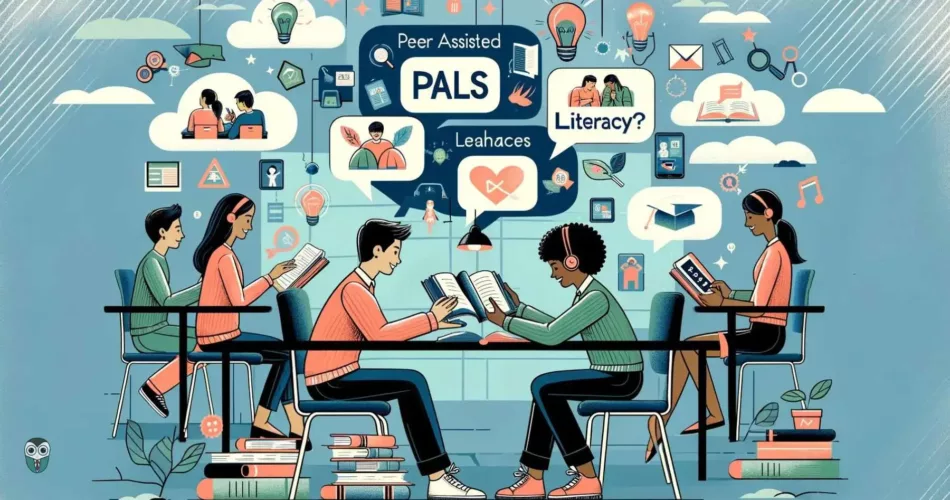Table of Contents
Peer Assisted Learning Strategies are an equivalent teaching program. It seeks to improve students’ reading and math skills. PALS executes in grades K-12. It spans many subjects and with a wide range of pupils. Also, it entails matching students with varied skill levels, who engage turns at tutor and tutees. They are involved in planned activities that give guided teaching and practice with academic subjects. It intends to add to the primary curriculum and work well with various schooling styles. Just like teamwork and collaboration, PALS fosters excellent social and other outcomes.
Peer Assisted Learning Strategies
The following article will provide insights into Peer Assisted Learning Strategies (PALS).
History of PALS
Peer Assisted Learning Strategies involve a complete teaching program based on the Juniper Gardens Study at the University of Kansas. It was studied at Vanderbilt over 15 years. Doug & Lynn Fuchs, along with others, developed it. They executed many studies to assess its value and viability in school settings.
PALS Reading and Maths
PALS Reading is a systematic reading practice ideal for preschool, grade 6, and high school kids. All pupils in the class are split into pairs. Every member of the team takes turns as a trainer and reader.
Similarly, PALS Math uses two primary coaching steps: coaching and practice. Learners work on a query sheet in their designated skill area at coaching. It includes adding & subtracting numbers, plots, and graphs.
Program Overview and Design
PALS aims to enhance, not substitute, current courses. Tutors choose and link kids who need help with skills to kids most suited to teach others those skills. Student pairings are often replaced. Even the items required for execution are few and affordable. They include a teacher’s guide, blank sheets, a projector, a pen, files, and a printer.
Different Reading PALS Programs
PALS programs include kindergarten, first grade, grades 2-6, and high school PALS. There are even programs for Peer Assisted Learning Strategies in Math.
Key Elements
1- Cooperative Learning
Cooperative learning involves students working in teams. The skill gap is mild; peers act as coaches and readers. It enables flexibility in education. Further, peers provide individual help because teachers know but have no time. However, peers can provide some expertise. So, pairings study ability-specific texts.
2- Highly Structured Interaction
Peer Assisted Learning Strategies is a pattern in which the trainer teaches how to engage during training sessions. Pupils practice the exercises and have defined duties. For Grades 2–6, the reader reads for 5 minutes. Then, the coach will correct any problems. Likewise, the coaching procedure includes a script, with each edition of the PALS having a series of initial training lessons that cover all activities. It even follows the corrective procedures.
3- Focus on Grade-Level Skills
Kindergarten applies phonological awareness, phonics, and fluency (limited). Phonological awareness (limited), phonics, and fluency are read in first grade. Fluency and comprehension skills are used in grades 2-6 and high school.
Moreover, students in grades 2–6 and high school participate in four tasks. It involves pair reading, retelling, paragraph reduction, and prediction relay. As books vary by pair, PALS doesn’t cover every skill. However, it trains critical abilities implied by the study.
4- Reinforcement of Academic Behaviors
In the points system, pairs receive regular points for performing tasks leading to a prize. In kindergarten, pairs receive instructor appreciation. For grades 1-6, pair points comprise the team total, and the winners receive class honors. Further, in high school, pair points are recast to buy prizes.
How Do You Set Up Peer Assisted Learning Strategies?
Peer Assisted Learning Strategies cover scheduling, assigning pupils, and preparing materials. Keep track of teaching, students, and points awarded.
1- Scheduling
Once patterns are set up, PALS takes place three days a week. K-PALS occurs for 20 minutes for 20 weeks. Grade 1 consists of 30 minutes weekly for 16 weeks.
2- Pairing Pupils, Trainers, and Readers
Divide the list and rank pupils based on their reading ability. Remember to match the best reader in the top and bottom half. Repeat this approach until every student has a partner. Also, use DIBELS ranking for Phoneme Segmentation for Midyear. Then, copy your report and trim at the midway. Pairs are then arranged. If the kindergarten class is proficient, use the same process.
Types Of Lessons
1- KPALS Teacher Games
Introduce Letters for weeks 1-5, 7-10, and 12-20 by pointing to a new letterbox, telling names, and the pupils repeat. For weeks 3-7, you can address sound blending by saying words slowly and asking kids for words. Likewise, during weeks 8-12, do the last sound, speak the word, and then ask the question.
Moreover, for weeks 13-17, pupils focus on segmenting words by learning to put a finger on every syllable. Letter-sound dialogue takes place between weeks 13-20. Finally, hear out words between weeks 16-20 to figure out how to pair sound symbols to interpret words.
2- KPALS Student Activities
Name Game (weeks 1–20) is played twice with name letters. Rhyme Time (weeks 1–5): switch roles after 3-4 minutes of paired graphics and rhyme detection. Also, First Sound (weeks 1–10) covers pictures with the first sound ID. Say the Word (weeks 6–15) features pictures and phoneme blending without switching roles.
Likewise, Last Sound (weeks 11–20) stretches on pictures and final Sound ID with switch roles. The Stretch It (weeks 16-20) includes pictures and phoneme segmentation. Each game is worth five points.
Starting Points
Student Training and First Lessons include the duties of coach and reader, scoring and earning points, KPALS restrictions, and pair behavior. Additionally, the following lessons focus on the story-sharing routine and the sounds and words activity.
Conclusion
The study stresses the potency of Peer Assisted Learning Strategies. It improves pupils’ vocabulary, learning, and speed. By engaging in organized social events, pupils improve their reading abilities. They create positive and cooperative spaces. It works on the point that teamwork makes the dream work. PALS gives teachers a chance to improve reading in various school contexts. Applying it may develop mutual duty and confidence among students. It results in higher academic success.
FAQs on Peer Assisted Learning Strategies
What are the advantages of highly structured interactions?
Peer Assisted Learning Strategies lengthen academic learning time. Plus, it fosters pleasant, learning-based social contact. It allows teachers to focus on every pairing.
Is it required to practice Peer Assisted Learning Strategies daily?
PALS does not occur daily. For kindergarten, it’s twenty or thirty minutes three times weekly. Similarly, 35-45 minutes three to four times a week are sufficient for first grade. For levels 2-6 and high school, an hour and a half three times a week is ideal.
I hope you enjoy our article, do check out more of our amazing articles.


Comments